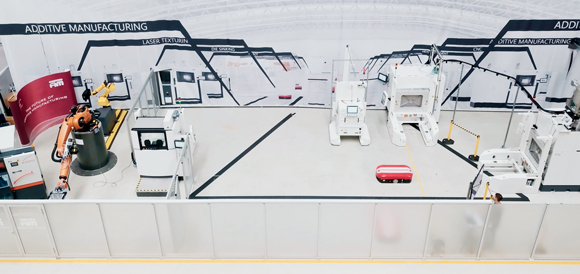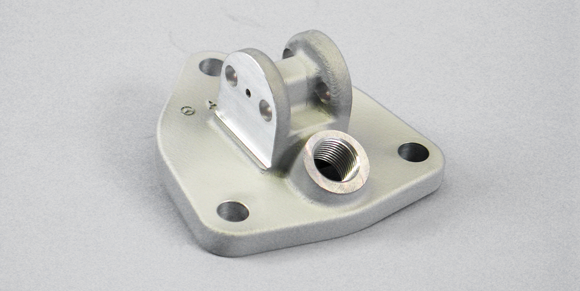NextGenAM project for automated metal Additive Manufacturing draws to a close
May 2, 2019

The built-up pilot plant of the NextGenAM project for automated Additive Manufacturing. From left to right: band saw, Kuka robot; background: three-dimensional optical measurement system, setup station, unpacking station; forefront: automated guided vehicle (AGV), EOS M 400-4 (Courtesy EOS)
NextGenAM, a pilot project for automated metal Additive Manufacturing, run jointly by EOS, Premium Aerotec and Daimler, has come to a successful conclusion. The project began in May 2017 and tackled the development of a production line for the automated Additive Manufacturing of aluminium replacement parts and series-production components for the automotive and aerospace sectors.
At the conclusion of the project, the partners reported that production of truck parts has begun using the pilot facility in Varel, Germany, and the potential for further components for both conventional and electric cars is being assessed. The findings of the project suggest that the cost of part manufacturing could be reduced by up to 50% using the automated production line, compared to currently available metal AM systems.
“As far as the aircraft industry is concerned, Premium Aerotec is today already an international pioneer in the field of metallic 3D printing,” stated Dr Thomas Ehm, Chairman of the Executive Board of Premium Aerotec. “The aim now is to build further on this expertise and to bring it to bear in other sectors as well. The successful conclusion of NextGenAM thus represents another important building block in our strategy.”
The new, scalable AM production line is said to be automated from beginning to end, meaning that no manual work is required at any stage of the process, from data preparation and central powder supply through to the AM build process itself, and including heat treatment, quality assurance and separation of the components from the build platform. The AM systems integrated within the pilot line are EOS M 400-4 four-laser machines for industrial metal AM. A driverless transport system and robots to ensure the smooth movement of the parts through every stage of the production line.
Fundamental to the system is the way the machines used are networked. Build job data are transmitted to the control centre, which prioritises the various build requests and allocates them to an AM system. During the build process, the manufacturing status can also be retrieved on a mobile device, independent of location. Once the full production chain has been completed, quality reports are sent back centrally to the control centre. All the data necessary for the production of a digital ‘twin’ can be accessed here, allowing complete traceability, amongst other things.

The first replacement part manufactured at Premium Aerotec for Daimler; a bracket for a truck diesel engine (Courtesy Daimler AG)
Dr Adrian Keppler, EOS CEO, commented, “We are very proud of what we have been able to achieve in collaboration with our partners Premium Aerotec and Daimler. The NextGenAM project has provided a very tangible demonstration of how industrial 3D printing can be used cost-effectively in series production as part of an automated process chain. In combination with the possibilities for digitalisation as used here, the pilot plant represents nothing less than a milestone along the way to digital manufacturing.”
Additive Manufacturing is particularly useful in the replacement part sector since it allows infrequently required parts to be reproduced without the need for often expensive tooling. Currently, a number of required replacement bus parts in aluminium are being examined at the Centre of Competence for Additive Manufacturing at Daimler Buses. The analysis team in the passenger car area is also said to be considering potential applications for the production line.
“Additive Manufacturing is also suitable for smallest-series production of new vehicles (limited editions). Systematic development of the parts specifically for 3D printing means that the production costs can be further reduced and the quality optimised”, added to Jasmin Eichler, Head of Future Technologies at Daimler AG. “3D printing also makes particular sense during the advance development of vehicles. The low numbers required can often be produced more cost-effectively, and faster, with Additive Manufacturing than with conventional production processes.”
For the automotive sector, the pilot facility uses AlSi10Mg, the material properties of which are said to have been continually improved over the course of the pilot project. The facility is also reported to have provisions in place for the use of Scalmalloy® for parts used in the aviation and aerospace sectors.
At the project’s conclusion, the pilot facility is said to meet the requirements of the industry standard VDA 6.3, one of the prerequisites at Daimler for the supply of series-production components by contract printing suppliers. In future, it is expected that the automation of the entire AM production chain will make it possible to manufacture larger batches in series production, with the same reliability, functionality, durability and economic efficiency as conventionally manufactured components.
















